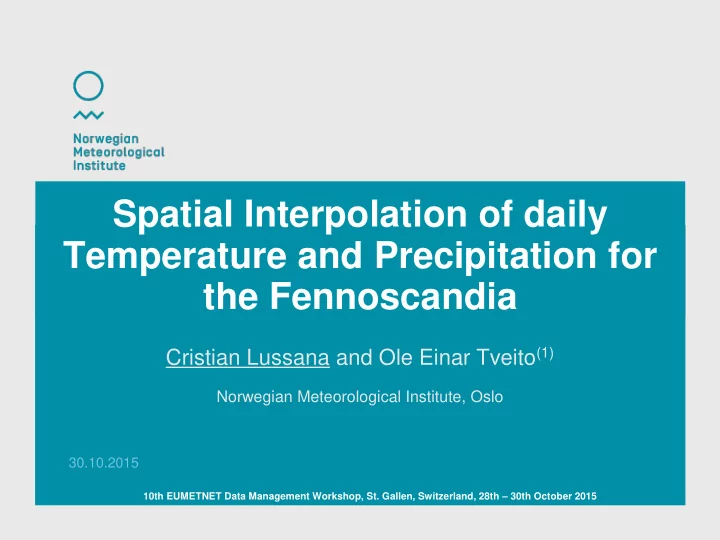

Spatial Interpolation of daily Temperature and Precipitation for the Fennoscandia Cristian Lussana and Ole Einar Tveito (1) Norwegian Meteorological Institute, Oslo 30.10.2015 10th EUMETNET Data Management Workshop, St. Gallen, Switzerland, 28th – 30th October 2015
http://blog.fmi.fi/nordmet/ 2 30.10.2015 Norwegian Meteorological Institue
Nordic Gridded Climate Dataset NGCD An observation gridded dataset for temperature and precipitation covering Finland, Sweden and Norway. - Spatial resolution 1Km x 1Km - CRS: EPSG Projection 3035 - ETRS89 / ETRS-LAEA - Temporal resolution: daily - Time range: 1981 - 2010 - Data sources: ECA&D, eklima.met.no, SMHI, FMI · Nordic observation gridded dataset will be an outcome of the Nordic Framework for Climate Services (SMHI, FMI, MI, (DMI,IMO)) · NGCD first versions: 2 from MET Norway, 1 from FMI and 1 from SMHI 3 30.10.2015 Norwegian Meteorological Institue
RR – daily precipitation + 24h PREC, Element descriptions in ECA&D: Norway : id=RR2 (D-1) 06UTC -> D 06UTC; Sweden : id=RR9 D 06UTC -> (D+1) 06UTC; Finland : id=RR5 D 07.30 -> (D+1) 07.30UTC; 4 30.10.2015 Norwegian Meteorological Institue
TG – daily mean temperature + Daily mean temperature, Element descriptions in ECA&D: Norway : id=TG9 (D-1) 6UTC->D 6UTC; Sweden : id=TG6 average using TN,TX,06,12,18; Finland : id=TG6 average using 8 observations; 5 30.10.2015 Norwegian Meteorological Institue
NGCD @ MET Norway Daily mean Temperature Residual Kriging (RK) Optimal Interpolation (OI) Daily accumulated precipitation Multi-Scale Optimal Interpolation (MSOI) Both OI products includes an automatic data quality control procedure (described in poster #14, Data Quality Control of Temperature and Precipitation in-situ observations based on Spatial Interpolation , Cristian Lussana and Ole Einar Tveito) 6 30.10.2015 Footer text
TEMP1d: Residual Kriging Kriging (or any spatial interpolation Residual kriging: method) ^ λ n t ( ) t(u ) ( ) ( ) ...... ( ) u u u u 0 0 0 0 0 1 1 2 2 i m m i i 1 External trend/drift T = TS + TD (linear regression) Trend predictors: • Altitude (station) • Mean altitude within a 20 km circle around the station • Minimum altitude within a 20 km circle around the station • Longitude • Latitude Linear stepwise regression is used to define the trend. 7 30.10.2015 Footer text
Grids of the independent variables Latitude Longitude DEM DEM_MEAN DEM_MIN 8 30.10.2015 Footer text
Regression coefficients 0.004 0.2 0.002 0.1 0 0 Coefficients position Coefficients terrain -0.002 -0.1 -0.004 -0.2 -0.006 -0.3 -0.008 -0.4 -0.01 -0.5 1 2 3 4 5 6 7 8 9 10 11 12 Month ALT DEM_MEAN DEM_MIN LAT LONG 9 30.10.2015 Footer text
Trend climatological first guess 10 30.10.2015 Footer text
TEMP1d: OI Large(coarser) scale trend estimation + OI introduces the Local(finer) scale 11 30.10.2015 Footer text
TEMP1d: OI NGCD seNorge2 12 30.10.2015 Footer text
NGCD.OI @ MET Norway – TEMP1d - Evaluation BLACK= Uncertainty gridpoints RED= Uncertainty, Large scale only BLUE= Uncertainty station points 13 30.10.2015 Norwegian Meteorological Institue
NGCD.RK @ MET Norway – TEMP1d - Evaluation BLACK= Uncertainty gridpoints 14 30.10.2015 Norwegian Meteorological Institue
NGCD.OI @ MET Norway – TEMP1d - Evaluation influence of station density/distribution 15 30.10.2015 Norwegian Meteorological Institue
NGCD.RK @ MET Norway – TEMP1d - Evaluation influence of station density/distribution 16 30.10.2015 Norwegian Meteorological Institue
NGCD.RK @ MET Norway – TEMP1d - Evaluation 17 30.10.2015 Norwegian Meteorological Institue
Spatial Interpolation Method based on Multi-scale Optimal Interpolation (Prec) Step 0: Identification of Precipitation Events (Observed Areas of Precipitation) (given the Station distribution) Event A Event B Events D,... Event C 18 30.10.2015 Footer text
Spatial Interpolation Method based on Multi-scale Optimal Interpolation (Prec) Given a single Event, the spatial interpolation is based on an iterative process: Coarser scale Given a predefined (horizontal) spatial scale. OI assumptions: OI Additive error model: obs scale = truth scale +err scale back scale = truth scale +err scale Gaussian errors: err scale = N(0,CovMat) OI CovMat = f( scale ,Vertical coord ) OI (through leave-one-out cross validation) is used to optimize the influence of the OI vertical coordinate in the error covariance matrix Finer scale 19 30.10.2015 Footer text
Multi-Scale Optimal Interpolation Step-by-step: from coarser to local scale 20 30.10.2015 Footer text
Multi-Scale Optimal Interpolation Step-by-step: predicted field 21 30.10.2015 Footer text
Evolution in time Footer text 30.10.2015 Multi-Scale Optimal Interpolation Multi-Scale Optimal Interpolation 22
Multi-Scale Optimal Interpolation Consistency along the borders 23 30.10.2015 Footer text
Case study: the New Year's Day Storm 1992 Aune, B., and K. Harstveit. " The storm of January 1st 1992. " DNMI Rapport NR 23 (1992): 92. 24 30.10.2015 Norwegian Meteorological Institue
the New Year's Day Storm 1992 25 30.10.2015 Norwegian Meteorological Institue
the New Year's Day Storm 1992 26 30.10.2015 Norwegian Meteorological Institue
Summary Within the NFCS, NORDGRID activity, we're establishing several observation-based gridded dataset of daily precipitation and temperature for the Fennoscandia region covering the period 1981-2010. Given the station distribution we expect to correctly describe the TEMP/PREC state down to the meso-beta scale (20-200Km). Bayesian/Residual Kriging spatial interpolation of precipitation and temperature show encouraging results. – Temp: on the average, Temperature analysis uncertainty is estimated to be between 0.6 ° C in the summer and 1.5 ° C in the winter. – Prec: Visual inspection of precipitation fields show realistic feature. Quantitative evaluation needed. 27 30.10.2015 Footer text
Recommend
More recommend